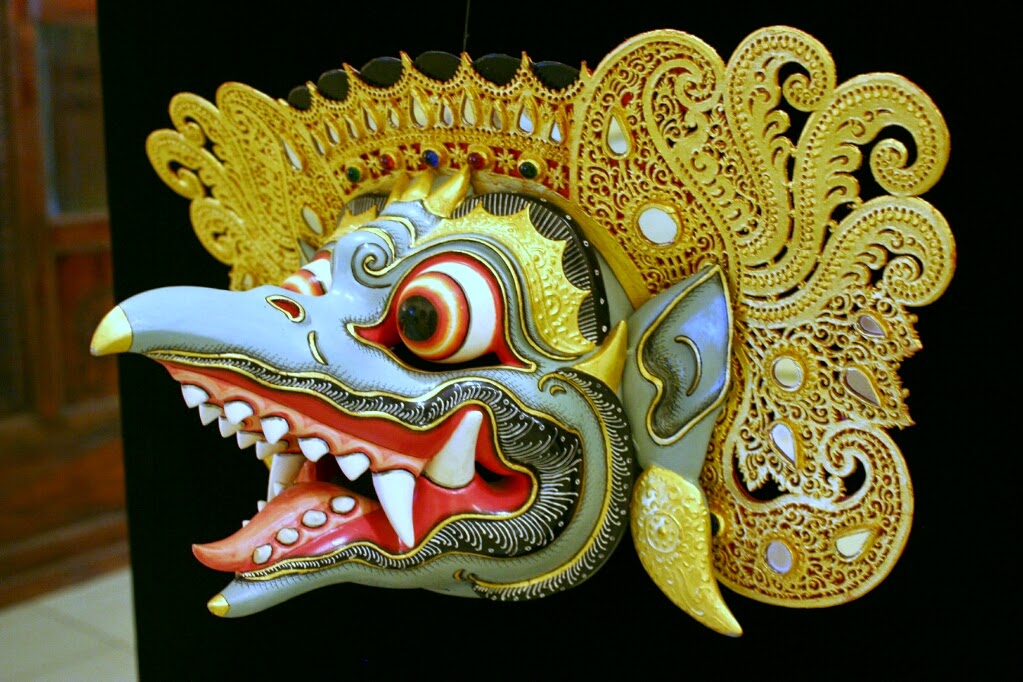Later, after dawn had broken, I was awoken again by the sound of sweeping. The Balinese are ritualistic about sweeping outside areas to the point of obsession. I'm not sure whether an equivalent phrase exists, but they seem to have taken to heart "cleanliness is next to Godliness". Any stray leaf is soon collected. Even standing rainwater is brushed away. It's an industrious sight and makes me wonder whether the Balinese also have a local version of the phrase "the Devil makes work for idle hands", as I have seen few indolent people here.
To contrast yesterday's western-style breakfast, we both get Indonesia's national dish this morning: nasi goreng.
 |
| Nasi goreng |
Fried rice is a comforting way to start the day and puts fuel in the tank. With some spicy sambal it also puts fire in the belly. Our stay at ARMA has been short but rewarding. We were made to feel part of the family and genuinely believed it was happy place to work.
 |
| Thumbs up for ARMA |
We walked ("walk?!") from the hotel out to the 9th century Goa Gajah or elephant cave. On the way we passed many more workshops with intricate and unusual carvings (a full-size surfing monkey complete with wave).
The mouth of the eponymous cave is an actual mouth, carved directly into the rock face, but is too small for elephants to fit through. It is said that the carving resembled an elephant.
 |
| Goa Gajah (Elephant Cave) |
As I have mentioned ad nauseum, central Ubud is busy, but out here in the surrounding villages of Gianyar - Bedulu, Pejeng, Kemenuh - the atmosphere is decidedly quieter. People wash their clothes, and clean wood sculptures in the stream running outside their house.
We circled around through quiet lanes to the Setia Darma House of Masks and Puppets.
 |
| The evil witch Rangda |
Set on a large plot of land, several buildings house only half of the collection of masks - thousands from all over Indonesia and beyond. It is a beautiful, quiet retreat, somehow off the tourist radar. We wandered through the collection entirely on our own, as though in the mansion of an absent millionaire.
Barong are the representations of good spirits and protector Bali from evil. The costumes are usually based on animals and each area of Bali has their own version, ranging from tigers, to goats and dogs. Below are barong gajah (elephant), barong bangkal (wild boar), and thr most famous barong ket (lion). The latter is from the Gianyar region, home of Ubud, and so is the one seen by most tourists.
 |
| Various barong |
In the background of the above photo are the tall barong landung. These are used to tell the tale of a 12th century bigamous king (Jaya Pangus) who, in search of an heir, married the princess of the lake, Dewi Danau. His first wife, Kan Ching Wie, was less than pleased about the arrangement when she discovered them. The Gods are similarly unimpressed and, in retribution, turned the couple into statues. Their effigies (the barong landung) are used to tell the story at the annual Galungan festival.
 |
| Garuda mask |
Most of the masks are for use in telling stories, and there is a whole pantheon of characters from epics such as the Ramayana. Fanged demons and gods, together with beautiful and wise (or ugly and stupid) human visages were on display.
 |
| Wayang puppets |
Making use of a similarly bewildering number of puppets is wayang - Balinese shadow puppetry. Master puppeteers are required to perform and remember each of the characters voices.
After our visit to the museum, we were picked up for a homestay in Taro, a village in northern Gianyar regency.
The road north of Ubud is lined with shops overflowing with handicrafts of a diverse nature. Eventually we passed the Tegallalang rice terraces and reached a quiet village.
Taro is home to the Pemulan organic farm and cooking school, which we had come to join tomorrow, taking the opportunity to stay over and experience village life.
Having dropped our bags, we walked to the nearby farm, where the afternoon cooking class was wrapping up. Tonight, we were prepared dinner using ingredients fresh from the farm.
 |
| Dinner at Pemulan farm |
A spinach, pumpkin and carrot salad (sayur urab) was transformed with fried kaffir lime leaf, chilli and fresh coconut. Tempe manis was crunchy and moreish with sweet shallot and garlic, while omelette and rice rounded out the meal. We still managed to make room for that signature Indonesian dessert, pisang goreng (banana fritter) with palm sugar and freshly grated coconut.
After dinner we sat in the bale (pavilion), drinking coffee, chatting with the local guys. One of them tried to teach K a tune on the tinklit - a Balinese bamboo xylophone, which is played sat on the ground. After a few repetitions, the pair of them managed to complete one round in unison. Every one of the men had some proficiency at the instrument and told us of their other skills in masked drama or dance. Everybody here has a talent and nurtures it. While there is a TV, nobody watches it.
Up here, far from Ubud and farther still from Denpasar, among good people, I finally feel as though I have seen behind the mask of Bali.
No comments:
Post a Comment